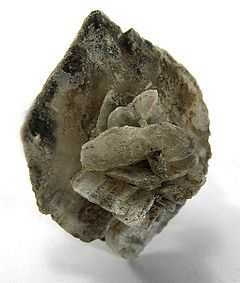Glauberite
| Glauberite | |
|---|---|
 Glauberite crystal group from the Bertram Siding Sulfate deposit, Imperial County, California | |
| General | |
| Category | Sulfate minerals |
| Formula (repeating unit) | Na2Ca(SO4)2 |
| Strunz classification | 07.AD.25 |
| Crystal symmetry |
Monoclinic prismatic H-M symbol: (2/m) Space group: C 2/c |
| Unit cell | a = 10.129 Å, b = 8.306 Å, c = 8.533 Å; β = 112.19°; Z=4 |
| Identification | |
| Color | Gray or pale yellow, colorless |
| Crystal habit | Tabular prismatic crystals |
| Crystal system | Monoclinic |
| Cleavage | Perfect on {001}, imperfect on {110} |
| Fracture | Conchoidal |
| Tenacity | Brittle |
| Mohs scale hardness | 2.5 - 3 |
| Luster | Vitreous to waxy, pearly on cleavages |
| Streak | White |
| Diaphaneity | Transparent to translucent |
| Specific gravity | 2.75–2.85 |
| Optical properties | Biaxial (-) |
| Refractive index | nα = 1.507 - 1.515 nβ = 1.527 - 1.535 nγ = 1.529 - 1.536 |
| Birefringence | δ = 0.022 |
| 2V angle | 24° to 34° |
| Dispersion | strong r > v |
| References | [1][2][3] |
Glauberite is a sodium calcium sulfate mineral with the formula Na2Ca(SO4)2, which forms as an evaporite.
It was first described in 1808 for material from the El Castellar Mine, Villarrubia de Santiago, Toledo, Castile-La Mancha, Spain. It was named for the closely related Glauber's salts after Johann Rudolf Glauber (1604–1668).[1]
It occurs in continental and marine evaporite deposits; as mineral sublimates deposited near fumaroles; in amygdules in basalt and in nitrate deposits in arid climates. It occurs associated with halite, polyhalite, anhydrite, gypsum, thenardite, mirabilite, sassolite and blodite.[3]
Because of its solubility, glauberite is often dissolved away from the crystal matrix leaving a mould into which other minerals are deposited as pseudomorphs.
References
| Wikimedia Commons has media related to Glauberite. |